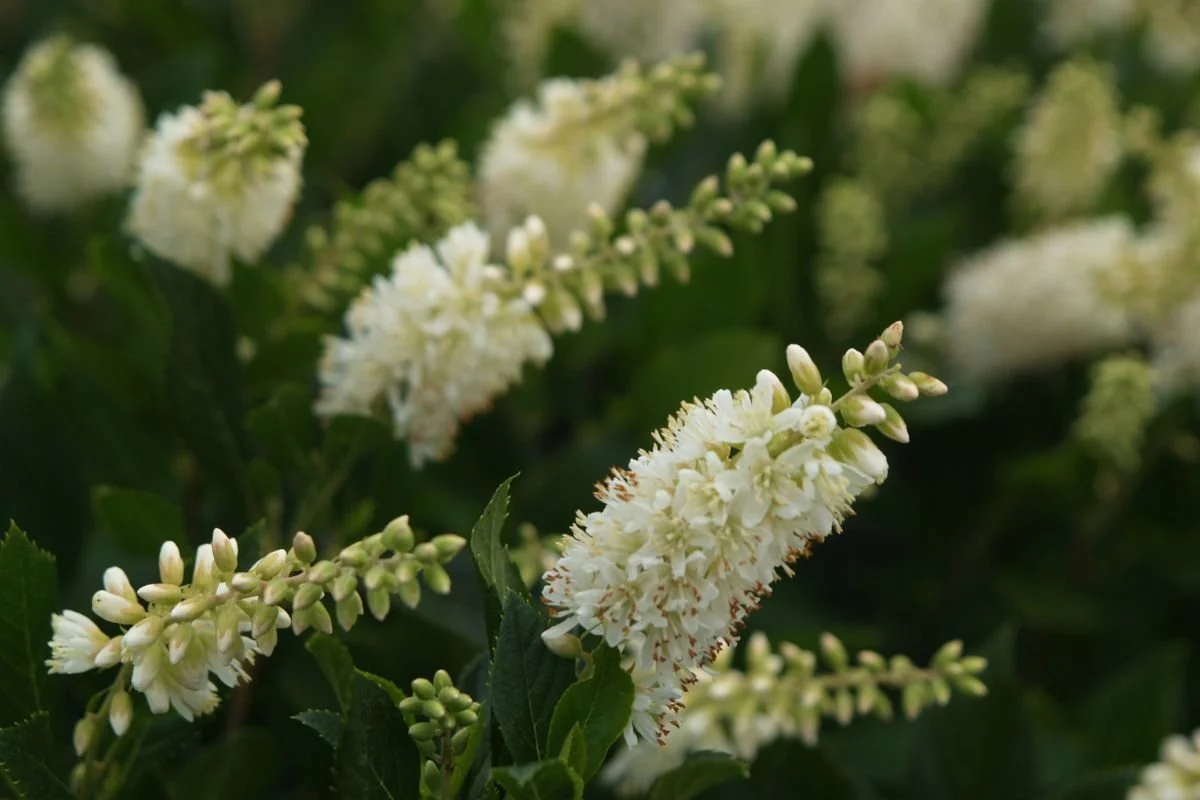Summersweet: The Ideal Pollinator Garden Addition
A Native Shrub That Keeps Your Garden Buzzing
If you want a garden that’s buzzing with life, summersweet (Clethra alnifolia), or sweet pepperbush, is a must-have shrub.
In summer, its fragrant, panicle-shaped flowers and glossy dark green leaves become a hotspot for bees, butterflies, moths, and other pollinators.
Even hummingbirds may stop by for a sip of nectar, while the dense foliage offers a cozy nesting spot for birds.
This adaptable, low-maintenance shrub thrives in various soil types, resists pests and diseases, and puts on a golden yellow show in fall.
Plus, its dried seed pods provide a much-needed food source for birds as the seasons change.
Bees and pollinators flock to the spiky summer blooms of summersweet (Clethra alnifolia).
Is Summersweet Deer Resistant?
According to Rutgers University’s list of “Landscape Plants Rated by Deer Resistance”, summersweet, also called sweet pepperbush (Clethra alnifolia), is considered seldom severely damaged by deer, making it a great choice for gardeners dealing with browsing wildlife.
While no plant is completely deer-proof, especially when food is scarce, summersweet’s fragrant flowers and thick foliage are typically unappealing to hungry deer.
For more details on deer-resistant plants, check out Rutgers University’s list to help you make the best choices for your landscape.
Sugartina® Crystalina Summersweet. Image courtesy of Spring Meadow Nursery, Inc. via Proven Winners, provenwinners.com.
How to Grow Summersweet (Clethra alnifolia)
Choose the right location – Summersweet prefers full sun to partial shade and moist, fertile soil. It tolerates short-term drought and flooding once established, but does not like consistently hot, dry sites. Understanding summersweet’s natural habitat (swampy woodlands, stream banks, and damp thickets of Eastern North America) can help you pick the best spot.
Plant in the right soil – Thrives in moist, fertile, slightly acidic soil but tolerates clay, periodic flooding, and full shade.
Water regularly – Clethra loves water! Keep the soil consistently moist, especially after planting. Read our in-depth guide on watering here.
Mulch for moisture retention – Spread mulch around the base of the shrub to help retain moisture. It’s very important to keep mulch about 3 inches away from the base of the shrub to avoid problems. Learn more about the dangers of overmulching your plants in Rutgers University’s article here.
Prune in late winter or early spring – Shape the plant lightly and remove any dead or diseased branches.
Be patient in spring – Summersweet is slow to leaf out, but don’t worry—it will happen, and the wait is worth it!
Expect a suckering habit – Grows in a dense, mounded clump and may spread over time.
Summersweet Fall Color
Summersweet Loves Water
Summersweet (Clethra alnifolia) thrives in wet conditions, making it a perfect solution for low-lying areas, rain gardens, and damp, shady side yards where other plants might struggle.
It can even be planted directly where downspouts drain, happily soaking up excess water and helping to manage slow-draining areas in your yard.
This water-loving shrub not only tolerates periodic flooding but also enhances your landscape with fragrant summer blooms and vibrant fall foliage, all while improving drainage in problem spots.
Summersweet Varieties
Clethra alnifolia, the straight species of summersweet, is the wild and original form of the plant as it naturally occurs in nature. It has white flowers and grows 5-10 feet tall and 4-6 feet wide, and maintains the species' genetic diversity and natural characteristics. It will be identified on the plant label as simply “Clethra alnifolia”, with no additional names or trademarks added.
Hummingbird (Clethra alnifolia ‘Hummingbird’) has a smaller, more compact shape and abundant white flowers. It grows 2-4 feet high and 3-5 feet wide, and is a great choice for smaller yards and foundations.
Pink Spires (Clethra alnifolia ‘Pink Spire’) grows 3-8 feet tall and has pale, shell-pink flowers.
Ruby Spice (Clethra alnifolia ‘Ruby Spice’) has bright rosy-pink flowers and grows 3-5 feet tall and wide (pictured below).
Sixteen Candles (Clethra alnifolia ‘Sixteen Candles’) has upright, erect white flowers and grows 4-5 feet tall and 2-3 feet wide.
Sugartina® Crystalina (Clethra alnifolia ‘Crystalina’ Sugartina®) is a small cultivar with a compact, rounded form and white flowers. It grows 2-3 feet high and 3-5 feet wide.
Summer Sparkler™ (Clethra alnifolia ‘Novacleein' Summer Sparkler™) has abundant long and squiggly flowers and grows a compact 3-4 feet tall and wide.
Vanilla Spice® (Clethra alnifolia ‘Caleb’ Vanilla Spice®) grows 3-6 feet tall and wide and is notable for its larger white flowers, up to twice the size of the straight species.
Ruby Spice, a summersweet variety with pink flowers.
Summersweet Garden Ideas
Plant summersweet clethra in the dappled shade of a woodland garden or alongside a pond or stream, mimicking its natural environment.
Use in a pollinator garden, hummingbird garden, or butterfly garden and watch birds, bees and butterflies flock to the summer blooms.
Plant a row of summersweet clethra along the length of a fence, softening the harsh lines of the posts and slats, or plant along a foundation.
Use in a mass planting, or combine with other evergreens and small trees to create a mixed privacy border.
Plant in any shady, wet area that is prone to standing water or periodic flooding, such as the low wet spots in your yard, or at the end of a gutter downspout or gutter extender.
Summersweet has a suckering habit and can be used to stabilize damp slopes, preventing erosion.
Butterflies love summersweet (Clethra alnifolia), making it the perfect choice for a pollinator or butterfly garden.
Summersweet Planting Companions
Jack Frost Siberian Bugloss (Brunnera macrophylla 'Jack Frost')
Brilliance Autumn Fern (Drypoteris erythrosora ‘Brilliance’)
Cardinal Flower (Lobelia cardinalis)
Japanese Painted Fern (Athyrium niponicum var. pictum)
Astilbe (Astilbe species)
The Rocket Leopard Plant (Ligularia ‘The Rocket’)
Venus Coral Bells (Heuchera ‘Venus’)
Purple Coneflower (Echinacea purpurea)
Patriot Hosta (Hosta ‘Patriot’)
Variegated Solomon’s Seal (Polygonatum falcatum ‘Variegatum’)
Chocoholic Black Bugbane (Cimicifuga or Actaea ‘Chocoholic’)
Oakleaf hydrangea (Hydrangea quercifolia)
Summer-flowering planting companions summersweet and oakleaf hydrangea.






